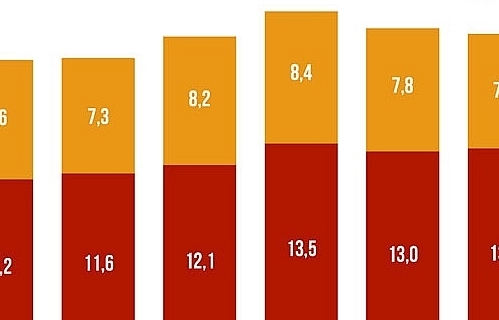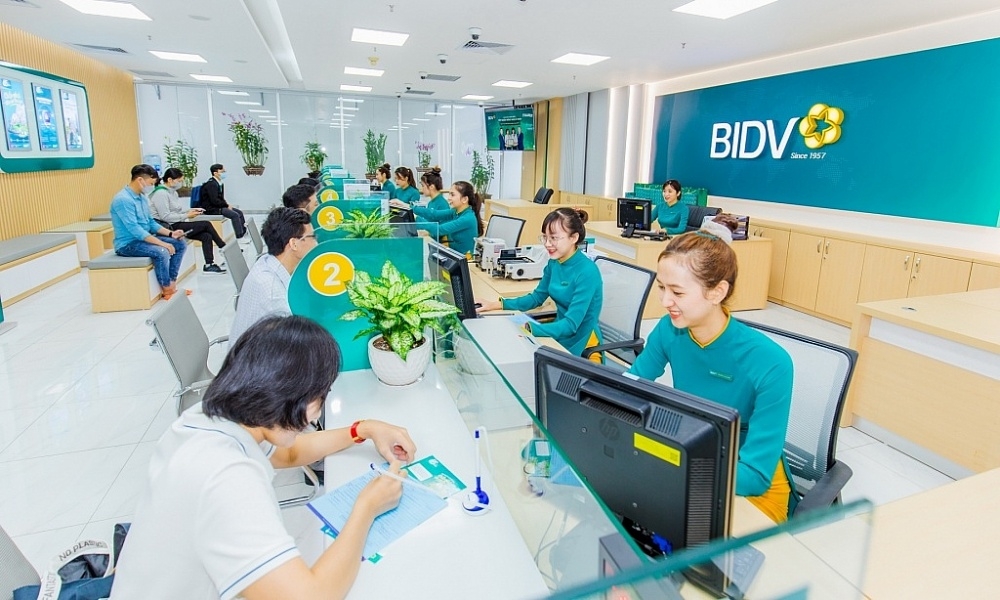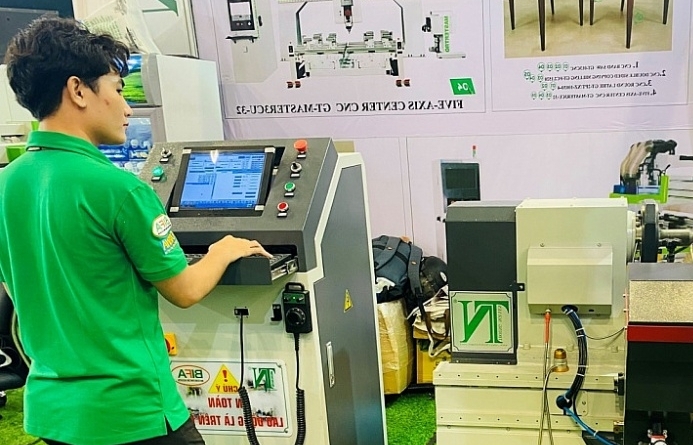Vietnam textile and garment strives to increase the localization rate
| Textile and garment exports in July reaches highest level over past year | |
| Textile and garment exports are expected to reach 40.3 billion USD | |
| Textile and garment exports recovered positively |
 |
| Fabric and yarn made from green hemp - one of the sustainable materials that Vietnam's textile and garment industry is focusing on developing. Photo: N.H |
Increasing gradually self-control
The strategy for developing Vietnam's textile, garment and footwear industry to 2030, with a vision to 2035 approved by the Prime Minister at the end of 2022, has set the goal of increasing the localization rate to 51-55% of demand. for the period 2021-2025 and 56-60% of demand for the period 2026-2030. However, according to Vitas, current domestic fabric production only reaches an output of about 2.3 billion meters/year, meeting 25-30% of demand. Although efforts have been made to reduce dependence on imported raw materials and increase the localization rate, Vietnam's textile and garment industry still depends on about 60% of imported raw materials and accessories from foreign countries. The lack of autonomy in raw material supply prevents enterprises from fully exploiting the industry's advantages.
In recent years, Vietnam has increased its integration into the world economy, actively participating in signing new generation free trade agreements (FTAs). With tax rates gradually decreasing to 0%, these FTAs create conditions for Vietnamese textile and garment enterprises to expand export markets besides traditional markets, with many opportunities to participate in international supply chains. However, to enjoy tariff incentives, businesses must meet the rules of origin according to each FTA, for example, with CPTPP the rule of origin is "from yarn onwards", with EVFTA it is "from fabric onwards". Therefore, if raw materials and accessories cannot be produced to meet origin requirements, the textile and garment industry will not benefit from FTAs and will continue to have to process with low added value.
The orientation of the textile industry is to take advantage of benefits from FTAs, gradually fill the gap due to supply shortages, gradually shift the focus to sustainable development, increase product value, and increase creative content. Thereby, gradually rising to a higher rank in the global value chain.
At the end of March, SAB Vietnam Co., Ltd. under Weixing Group held the inauguration ceremony of SAB Vietnam industrial factory in Bim Son Industrial Park (Thanh Hoa). In the early stages, the factory mainly produced zippers, hardware accessories and alloys. Mr. Vu Duc Giang, Chairman of Vitas, said that in addition to the SAB factory, since 2023, many foreign investment projects in the textile and garment field have been started and put into operation in Vietnam. “A series of the world's leading fabric and thread manufacturers have invested in Vietnam. That shows the special attractiveness of Vietnam's textile and garment industry to foreign investors" - Mr. Giang said.
According to Mr. Giang, FDI investment projects in raw materials and accessories when put into operation will meet huge demand, helping Vietnamese textile and garment be proactive in domestic materials, be proactive in time, and reduce transportation costs. …compared to imports from abroad. This also contributes to reducing the supply shortage, reducing imports, and increasing the export trade surplus for the textile and garment industry.
In addition to new FDI projects, many domestic enterprises are also trying to improve the supply chain to increase autonomy in raw materials. Typically, Thanh Cong Textile - Investment - Trading Joint Stock Company (TCM) has built a closed process from yarn - knitting / weaving - dyeing - sewing. Proactively sourcing input materials from fibers and fabrics has given TCM a competitive advantage as well as enjoying preferential tariff advantages from FTAs such as CPTPP, EVFTA... In addition, natural fiber products, Recycled fibers... are also being researched, invested in and developed by many businesses.
Needing strong support from policy
Although there have been many significant advances, Mr. Vu Duc Giang believes that there is a lot of work to be done for the textile and garment industry to achieve the target of localization rate set out in the Vietnam Textile, Garment and Footwear Industry Development Strategy to 2030, vision to 2035.
The textile industry has an imbalance between production stages. The two stages at the beginning and end of the chain, yarn and sewing, have a very large scale of development, while weaving and dyeing have remained the bottlenecks of textile and garment for many years. Infrastructure for weaving, dyeing and fabric production is limited. There is no spatial planning for development and centralized wastewater treatment. Some localities refuse textile and dyeing projects, saying that the textile and dyeing industry causes pollution, although investors affirm that they will use modern processing technology that will not have a negative impact on the environment.
One of the reasons is that the issued policies are not strong enough and not commensurate with the scale and role of the industry. The state has a number of preferential policies for the textile and garment industry, but for a long time they are spread out, not focusing on really difficult and complicated stages (such as weaving, dyeing and finishing, supporting industries). …).
Therefore, Vitas recommends that the Government and state agencies promulgate mechanisms and policies to reduce costs for the business community, and build favorable policies and regimes for the operations and development of businesses in the future industry, policies to support the development of competitiveness for the textile and garment industry. Mainly support policies on credit, research and development (R&D), human resource training, and policies to encourage the import of high technology and clean technology in the textile and garment industry.
Vitas has proposed a specific program to implement the Vietnam Textile, Garment and Footwear Industry Development Strategy to 2030, with a vision to 2035; recommend that the Ministry of Industry and Trade and localities build large textile and garment industrial complexes and parks in a number of qualified localities with modern wastewater treatment systems, ensuring sustainability and safety for the environment, meeting increasingly stringent legal requirements.
In addition, Vitas also continuously updates and introduces preferential investment policies of Vietnam in general and the textile industry in particular, especially the supporting industries of weaving and dyeing production, to foreign partners. outside; Provide incentives and encourage businesses to invest in new machinery, equipment and technology to reduce energy consumption and reuse wastewater. Accordingly, only attract high-tech textile and dyeing investment projects, invest in the production of new materials of natural origin, and comply with labor and environmental standards.
Related News

An Giang Customs issues many notes to help businesses improve compliance
09:29 | 20/12/2024 Customs
Latest News

Top 10 Reputable Animal Feed Companies in 2024: Efforts to survive the challenges of nature
18:30 | 21/12/2024 Import-Export

Vietnam's import-export surges 15.3%
09:44 | 20/12/2024 Import-Export

More Vietnamese firms interested in Saudi Arabia: Ambassador
09:43 | 20/12/2024 Import-Export

“Give and Take” in the Value Chain of the CPTPP Market
09:30 | 20/12/2024 Import-Export
More News

Binh Dinh province works to attract investment from Japan
15:44 | 19/12/2024 Import-Export

Agricultural, forestry and fishery exports “reach the target” early
15:20 | 19/12/2024 Import-Export

Thailand remains Vietnam’s biggest trading partner in ASEAN
15:35 | 18/12/2024 Import-Export

Rubber value soars in 2024: VRA
15:33 | 18/12/2024 Import-Export

Vietnamese businesses struggle to access green finance
09:58 | 18/12/2024 Import-Export

E-commerce: a gateway to boost Vietnamese commodities in the UK market
16:55 | 17/12/2024 Import-Export

Agro-forestry-fisheries exports top 62 billion USD in 2024
16:51 | 17/12/2024 Import-Export

Removing “bottlenecks” for digital transformation in industrial production
10:00 | 17/12/2024 Import-Export

UKVFTA facilitates Việt Nam's tuna exports to UK market
13:56 | 16/12/2024 Import-Export
Your care

Top 10 Reputable Animal Feed Companies in 2024: Efforts to survive the challenges of nature
18:30 | 21/12/2024 Import-Export

Vietnam's import-export surges 15.3%
09:44 | 20/12/2024 Import-Export

More Vietnamese firms interested in Saudi Arabia: Ambassador
09:43 | 20/12/2024 Import-Export

“Give and Take” in the Value Chain of the CPTPP Market
09:30 | 20/12/2024 Import-Export

Binh Dinh province works to attract investment from Japan
15:44 | 19/12/2024 Import-Export




